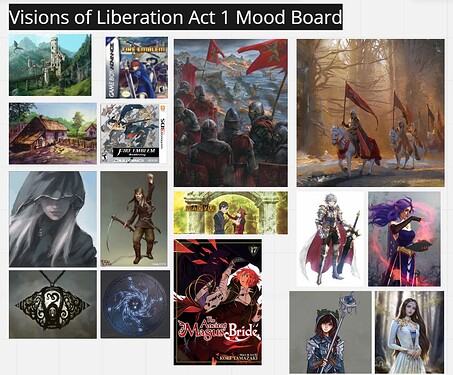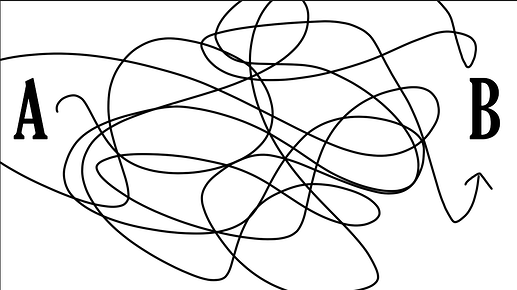I am not sure if this has been done or not. But I always find joy in finding inspirations for any design work. Whether it’s as broad as world building to the simplest things like How do the Christmas Cavs talk to each other in the support. After reading a thread from a year ago named “Inspirations for your work”, I have a gut feeling that ideation and concept building has not been talked enough here so. Let me talk about it for a while.
“Who am I to talk about Ideation?”
Before you guys start having doubts about a rando telling you how to make ideas for hack, I can assure you I have studied this field. I have been studying Multimedia Arts for more than four years now and I have been working in pre production for different media based companies as well; so this comes naturally to me. I am here to give insights on this field that I feel like is not talked enough and will never be talked enough. And this thread will focus on three things I find essential in getting ideas: Finding inspirations, my personal favorite ideation methods, and how you can communicate your hack ideas to others.
Inspiration Finding
I always believe that inspirations are the seeds of ideas. And whenever people ask me where do I find inspirations for ideas or where do I start finding ideas, I always tell them one thing.
“There is no such thing as a bad inspiration for an idea!”
As long as it is a starting point, there is no bad inspiration.
Let me use my WIP hack, Visions of Liberation, as the sample here for the thread. I found inspiration for this surprisingly from a mix of different games and series. I believe from the time I started writing down the groundwork of the idea I just finished playing a Dungeons and Dragons game where I brought the party to investigate a manor which belonged to a fallen lord. When I revisited the map design I had for the party I thought that it would make a good Fire Emblem Map. So that is where the hack began for me as I wrote down and still writing down details for the hack.
*The starting point of Visions of Liberation and how it was put into fruition.*
Another hack I was inspired with to make this thread is 7 Siblings by Warpath. In the linked interview with Warpath showed that the story aspect of the hack is loosely based from family members. For me that is a creative starting point to create a hack as a medium for storytelling based off family. It gives like a fresh perspective to what family is for we all came from different family backgrounds. And I just find it amazing how the hacker translated real life family events into a high fantasy story in 7 Siblings.
The main takeaway from this is that there is no wrong starting point. I got my hack’s start from a DnD Map of all things hahaha. I can see everyone getting inspiration from different things from movie scenes, game mechanics, and even just conversations with people and how they talk works (True story since I based one character in my hack based off a conversation I had with an IRL friend of mine.) If you can pinpoint that inspiration which stemmed from one thing that you personally like about anything and find a starting point from there, then that means you found yourself an idea you can cultivate.
Ideation Method 1- Mood Boards
Another way to note down and track inspirations is a mood board. Mood boards ,in my own words, is an organized collection of visual pegs which tells the idea.
I personally love mood boards because it gives me a visual guide to what the concept or idea is. It also serves as the first proof of concept shown to others that will describe what your product is; in this case, what your hack is.
*My mini mood board for Visions of Liberation's planned Act 1*
You do not have to have a formal set format or style on how to do mood boards. You can make something well decorated and organized or a minimalist organized chaos of a board. The important thing about mood boards are these pointers.
- The idea is well visualized
In my mood board example, I am attempting to communicate an idea to the viewers. Without using any words I am depicting a large scale army attack, a dark relic in the hands of a mysterious organization, gameplay elements inspired by FE7 and Awakening, storytelling styles, and samples to the aesthetics to the world (Both characters and geography.) The images are not there to give the full context of the idea but it is there to give a general idea of what is planned and what are the parameters and goals of the hack.
- The idea strikes a conversation
I keep it to a minimum of just images to communicate with the viewers because I want to strike a conversation. I shown this to my friends before and it allowed communication to happen. Things like “What are those princess designs for?” or “Why are there Anime titles?” If you are able to visually communicate your ideas and the viewers are able to start a conversation around the mood board you made, you have successfully made a good mood board which is able to do it’s job. I personally love looking at my peers mood boards for their projects despite it not being around my field of arts and it gives out a lot of good insight and even more inspirations just presenting and reviewing mood boards.
Ideation Method 2-"The Worst Idea Method"
This form of ideation is something I personally like involving myself in since it is a more feedback focused method.
The concept behind the worst idea method is pitching a subjectively bad idea and see how others would react to it. This is done through communicating with people about what you think is a bad idea and how we think it should be implemented here. The goal of this method of ideation is to provide a negative pitch on an item, get feedback from others on what makes it a bad idea, and how can an idea be translated to a good idea.
I have done this before with my idea of adding in a star shard system to my hack. I pitched in an idea for a certain star shard to lower the growth rate of every stat a unit has in exchange for more EXP gains. After some conversation within the FEU discord it then revealed that my idea is a bad idea because it is a held item which incentivizes trade trains. Therefore from feedback from others it was then formed into a good idea by making it a consumable item for them to commit to the lower stat growths.
This practice is good in my opinion because of a few things.
-
It encourages any idea to be promoted as a “good idea”
With everyone pitching bad ideas and hot takes on how a hack should be designed, it can give insights on how things can be turned from a bad idea into a good idea. Bad ideas for me are just like leftovers. It can either go bad or become a good meal depending on how we treat it. -
It helps us practice how we take in feedback
The detriment of any creative project is not getting feedback. The final design is never the final design. What makes a design work is how it is received by the target audience. Through this method we know we are pitching bad ideas, and thus criticisms are bound to happen. If we steel ourselves in an environment where we know we cannot sell our bad ideas, we are setting ourselves up to better ideas which is of course to the benefit to our hacks.
Ideation Method 3- SCAMPER
SCAMPER stands for, “Substitute, Combine, Adapt, Modify, Purpose, Eliminate, Reverse”. The goal of this ideation method is to put your hacks into different what if scenarios on what the hack would look like in different iterations and implementations. This one can be done by yourself and can take as long as you need. The important thing with the SCAMPER method is to exercise the idea by running it through a gauntlet of sub ideas. I’ll show a sample SCAMPER I will soon make soon as I was conceptualizing my Class Promotion Tree for Visions of Liberation.
For now the main benefit of SCAMPER is to lay out ideas and what are the substitutes are. By identifying the different sub ideas into the main idea, you can further elaborate a certain aspect of your hack by defining other fields it can work with.
Main Takeaway
There are a million ways to get ideas for your hack. I only presented a few of the methods I personally used in my field and how it can apply to your personal creative endeavors. Also, do not get discouraged if an idea does not work. I do not believe that an idea can come across in a linear fashion.
Instead, I would highly encourage for ideation to be more of a messy process of going back and forth filled with a lot of revisions and feedback in order to achieve the full potential of your hack ideas!
I hope that through this small tutorial I wrote, it can help you as well in creating your next hack idea.
To the Readers
As practice to what I just wrote, I want you to try and apply one of these methods to your hack ideas and see how it helps you present and refine your current ideas. The main point is to see what direction these methods bring your ideas to and how it helped you ideate more concrete and amazing ideas. Can’t wait to hear your ideation stories here in this thread!




